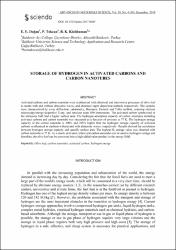Storage of hydrogen in activated carbons and carbon nanotubes

Göster/
Erişim
info:eu-repo/semantics/openAccessAttribution-NonCommercial-NoDerivs 3.0 United Stateshttp://creativecommons.org/licenses/by-nc-nd/3.0/us/Tarih
2018Üst veri
Tüm öğe kaydını gösterÖzet
Activated carbons and carbon nanotube were synthesized with chemical and microwave processes of olive leaf in media with and without ultrasonic waves, and chemical vapor deposition method, respectively. The samples were characterized by x-ray diffraction, calorimetry, Brunauer, Emmett and Teller method, scanning electron microscopy/energy-dispersive X-ray, and zetasizer nano S90 instruments. The activated carbon synthesized in the ultrasonic bath had a higher surface area. The hydrogen adsorption capacity of carbon structures including activated carbons and carbon nanotube was measured as a function of pressure at 77 K. The hydrogen storage capacity of the carbon nanotube is 300% and 265% higher than the hydrogen storage capacity of activated carbons synthesized in medium without and with ultrasonic waves, respectively. Results showed the correlation between hydrogen storage capacity and specific surface area. The highest H-2 storage value was obtained with carbon nanotube at 77 K. As a result, activated carbon and carbon nanotube can be used in hydrogen storage and therefore, the olive leaf can be converted into a high added value product in the energy field.
Kaynak
Advances In Materials ScienceCilt
18Sayı
4Koleksiyonlar
Aşağıdaki lisans dosyası bu öğe ile ilişkilidir:


















